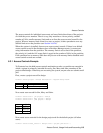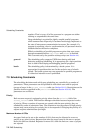How Access Controls are Applied
allocated has its memory limits set to this value. A process with more than one CPU
allocated has proportionately higher memory limits.
The RMS_MEMLIMIT environment variable can be used to reduce the memory limit set by
the system, but not to raise it.
By default, the memory limit is capped by the minimum value for any node in the
partition of the smaller of these two amounts:
1. The amount of memory on the node.
2. The amount of swap space.
If lazy swap allocation is enabled (see Section 7.4.2), the memory limit is capped by the
minimum value for any node in the partition of the amount of memory per node.
6.4.2 Priority Rules
The priority of a resource request is derived by applying the following rules in sequence
until an access control record with a priority is found.
1. The root user has priority over all other users.
2. If the user has an access control record for the partition then this record determines
the priority.
3. The access control record for the user’s current project determines the priority.
4. The access control record for the default project determines the priority.
Having selected an access control record, the priority of the resource request is set by
the value of its priority field. A null value sets the priority to 50, the default. Higher
priority jobs are scheduled first. The user can instruct rcontrol to lower the initial
priority but not to raise it. An administrator can raise or lower priorities.
6.4.3 CPU Usage Limit Rules
RMS keeps track of the number of CPUs in use by each user and each project. A request
to allocate additional CPUs is blocked if it would cause the usage limit for the user or the
usage limit for the user’s current project to be exceeded. The request remains blocked
until the user or other users in the user’s current project free enough CPUs to allow the
request to be granted. The CPUs can be freed either because the resources are
deallocated or because the user suspends the resource using rcontrol.
The CPU usage limit is derived by applying the following rules in sequence until an
access control record with a CPU usage limit is found.
Access Control, Usage Limits and Accounting 6-5


















